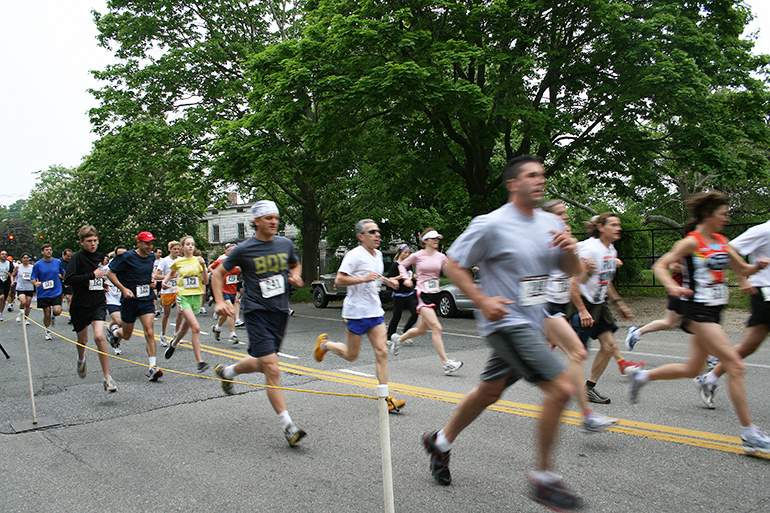PotatoHampton: Tales from the Hamptons' First 10K Race

I watched the New York City Marathon on television the other day. What a sight—more than 50,000 cheering runners heading out with the bang of the starting gun to come up a ramp and begin across the Verrazano Bridge from Staten Island to Brooklyn.
It made you wonder if such a crowd, banging their feet on the pavement all together, might dangerously sway the bridge. Those 50,000 runners all crossing at the same time. Do the math. Just the dead weight is 8 million pounds. I think even a traffic jam of cars might not disturb the bridge that much.
Watching the enormous crowd pumping across that bridge brought to mind a story about the little Sagg Bridge that separates Bridgehampton and Sagaponack and the time that the authorities in these parts feared for its safety during a running race.

The run was the Dan’s Papers PotatoHampton Minithon, the first organized run ever held in the Hamptons. It debuted on the Sunday of Memorial Day weekend in 1973. The New York City Marathon had begun three years earlier with just 173 runners and was still in its infancy. Out here, the PotatoHampton attracted an amazing 500 runners in its first year. I had never expected that many. I just thought it would be nice to take the summer people running by some of the beautiful historic sites of our area.
Related: Soaked and Stoked at Dan’s Papers PotatoHampton 5K
The start sent the runners down Main Street in Bridgehampton (the police closed down the Montauk Highway for that!) and it passed the Bridgehampton Museum, the old barn and 1907 Bridgehampton Jail, turned south on Ocean Road, went past the 19th century Beebe Windmill, the Sagaponack one-room schoolhouse, the Sagg General Store, and the little historic Sagg Bridge. The finish line was on the lawn of the Bridgehampton Presbyterian Church, and every participant got a potato from the back of a potato truck we arranged to have parked on the lawn there. We gave out two trophies. Fastest man and fastest woman.

People loved the PotatoHampton 10k. It became, on Memorial Day, a marker for the start of summer. Some years we gave out prizes for best costume. I recall one runner dressed as a baked potato. Another year, three people ran together as french fries.
But the year I remember most was the 1981 PotatoHampton. The route we chose was the same one as always. Main Street, museum, windmill, Sagg School, Sagg General Store and Post Office, Sagg Bridge. Two days before the race, with all the preliminaries taken care of, maps printed out and everyone ready to go, I got a call from the Southampton Town Supervisor. He told me we could not cross the Sagg Bridge.

He told me the bridge—a lovely, arching hundred-yard hump in the road crossing Sagg Pond—was determined to be weakening and in need of repairs. And I knew that. Indeed, it had been shut down to vehicle traffic for about a month. No cars allowed. It would be shut down for five more months.
But it was not shut down to people walking across it. A sidewalk adjacent to the side of the road crossed the bridge. Every day, people walked across to get to the other side or stopped in the center. Others often fished over the railing. So how could this be? And how could I possibly change the route at the last minute when the bridge was measured into the 10k length exactly?

“We’re pedestrians,” I said. “Pedestrians are allowed on the bridge.”
“We’re afraid what would happen if they all ran across the bridge at the same time.”
“They head out from Main Street all at the same time, but this is three quarters the way through the run. The runners are all spaced out by that time, from front to back maybe half a mile. Just a few cross together, maybe 10 in a bunch or so.”
“The board fears what might happen if they all marched across in lockstep.”
Lockstep is like what a marching band does. Right, left, right left.
“Nobody runs in lockstep.”
“Tell you what. If you could station someone with a bullhorn where they start to cross the bridge telling the runners not to run in lockstep, I think I could talk the board into letting the PotatoHampton runners cross the bridge.”
We had staff and friends volunteering for this race, manning registration tables and water stops, standing at street corners waving the runners around the turns. I asked the person who was organizing the volunteers that year, Linda Shapiro, to get such a person and station him or her at the start of the bridge.

And so, at the usual 9 a.m., everyone crowded onto Main Street in front of our office behind a starting line, a gun sounded and the race began. I was in the backseat of the lead car ahead of the runners when the gun went off, and so told the driver to speed on ahead of them to drive the course and along the way make sure everyone was where they were supposed to be. Indeed, at the foot of the bridge, a man I did not recognize held a bullhorn, waiting to do his job. I pulled over.
“Thanks for coming,” I said. “Also, tell me your name and where you’re from? I need the info for my article in the paper next week.”
“Fred Walters. From Water Mill.”
“Occupation?” I asked.
“Psychiatrist.”
I looked at the bridge, at him, at his bullhorn.
“That figures,” I said.
I thanked the Supervisor for all this afterwards. Since that date, there have been numerous repairs and restorations made to that little bridge. At times it’s been shut completely, with not even pedestrians allowed to cross, and we’d known that ahead of time and made arrangements to modify the course. But I’ve never forgotten the psychiatrist who manned the bullhorn at the foot of the bridge warning runners not to act like nuts.
Soon after our race kicked things off, big volunteer races for charity came on the scene—Ellen’s Run, the Shelter Island Run, the Montauk Triathlon, etc.—and as we were doing this only for the fun of it, we bowed out of running our PotatoHampton in 2011.
It was a lot of work, was expensive to pull off and, as you might say, we had other fish to fry.




